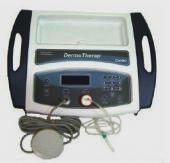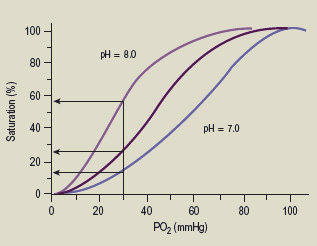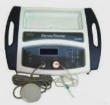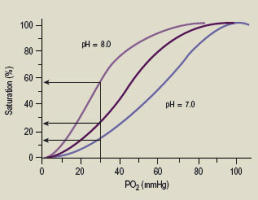


Carboxytherapy
is
a
mesotherapy
like
non-surgical
procedure
used
to
infuse
CO2
gas
below
the
skin
(sub-cutaneous
or
intradermic)
through a tiny 30G mesotherapy needle.
Because
CO2
is
non-embolic
it
is
very
safe
if
done
with
the
correct
protocols
and
pre
treatment
medical
consultation with a doctor.
Carbon
dioxide
is
a
natural
by
product
of
the
body
and
is
not
toxic
even
in
elevated
doses
unless
a
pre
existing
medical condition exists. There are no known risks associated with carboxytherapy.
In
normal
physiology,
our
cells
produce
CO2
as
a
by-product
of
cellular
respiration,
the
process
of
breaking
down sugars or fats with oxygen.
After a treatment the gas is totally reabsorbed within 5 minutes and the area treated returns to normal
Carboxytherapy
originated
at
the
Royal
Spas
of
France
in
1930
with
the
treatment
of
patients
afflicted
by
peripheral
arterial
occlusive
disease.
CO2
therapy
has
been
applied
to
the
treatment
of
stretch
marks,
cellulite,
and
hypertrophic
scars
with
impressive
results.
Studies
have
demonstrated
that
carboxytherapy
improves
skin
elasticity,
improves
circulation,
encourages
collagen
repair,
improves
the
appearance
of
fine
lines
and
wrinkles,
and destroys localized fatty deposits.
Carboxytherapy is a safe, minimally-invasive Non-surgical procedure that bears minimal risks of side effects.
Mechanism of action
Vasodilatation
The first effects following CO2 injection is a strong vasodilatation, a blood flow increase and a higher pO2 in the treated area.
The Bohr effect
Local
oxygen
release
is
improved
because
of
the
Bohr
effect.
The
Bohr
effect
describes
the
tendency
of
haemoglobin
to
have
less
affinity
for
oxygen
when
the
blood
concentration
of
CO2
is
increased.
This
lower
affinity
leads
the
haemoglobin
to
release
the
oxygen
better
in
superficial tissues and muscles. CO2 is quickly converted to bicarbonates and H+ acid in presence of the carbonic anhydrase enzyme.
CO2 + H2O --> H+ + HCO3-
This
reaction
causes
the
tissue’s
pH
to
become
acidic
with
even
more
dissociation
of
O2
from
haemoglobin,
allowing
the
tissue
to
become
even more oxygenated.
Stimulation of collagen synthesis
A
2008
Brazilian
study
showed
a
reorganization
of
collagen
fibers
following
intradermal
injections
of
carbon
dioxide
and
demonstrated
that
the
CO2
is
capable
of
increasing
the
collagen
turnover:
a
trauma
to
the
dermis
launches
a
healing
process
with
collagen
synthesis.
CO2
improves
the
process
by
first,
increasing
neovascularization
with
more
healing
substances
and
factors
to
be
on
site.
In
second,
it
releases
more oxygen around and in the healing area, improving the recovery phase.
Neo-angiogenesis effect
The
first
experiments
in
the
1930s
consisted
of
injecting
CO2
into
the
leg
of
a
frog.
They
have
shown
a
strong
vasodilatation,
associated
with the creation of new capillaries.
Receptor activation and lipolysis cascading improvement
The
pressure
receptors
are
stimulated
by
CO2
injections.
Cascading
reactions
improve
the
lipolysis
process
in
the
injected
areas.
CO2
is
improving the natural lipolysis capabilities of the body.
Safety
CO2 is a non-toxic & non-embolic gas.
It doesn’t increase blood pressure
It doesn’t increase CO2 in blood.
It doesn’t produce free radicals
There isn’t any risk to produce allergy
It doesn’t damage connective tissue and we can use it in all areas of the body
There isn't any local or general risk
It's eliminated by lungs, kidneys and skin
Click the following links for more information:
1.- Introduction
2.-
Indications
3.-
Contraindications and side effects
4.-
Frequently asked questions
5.-
Photo Gallery
If
you
would
like
additional
information
regarding
our
services
or
to
request
an
appointment,
you
can
contact
us
by
phone
(952
80 53 68) or by
email
.


© 2023 - Centro Medicina Natural y Antienvejecimiento - Neural therapy, Homeopathy, Ozone therapy, Carboxytherapy, Mesotherapy
Avda. Juan Carlos I, nº 29, portal 5, 2ºB -- 29680, Estepona (Málaga)





© 2023 - Centro Medicina Natural y Antienvejecimiento
Tel: 952 80 53 68
E-mail: info@medicinabiologica.es
Introduction
Carboxytherapy
is
a
mesotherapy
like
non-
surgical
procedure
used
to
infuse
CO2
gas
below
the
skin
(sub-cutaneous
or
intradermic)
through
a
tiny 30G mesotherapy needle.
Because
CO2
is
non-embolic
it
is
very
safe
if
done
with
the
correct
protocols
and
pre
treatment
medical
consultation
with a doctor.
Carbon
dioxide
is
a
natural
by
product
of
the
body
and
is
not
toxic
even
in
elevated
doses
unless
a
pre
existing
medical
condition
exists.
There
are
no
known risks associated with carboxytherapy.
In
normal
physiology,
our
cells
produce
CO2
as
a
by-product
of
cellular
respiration,
the
process
of
breaking
down
sugars
or
fats
with
oxygen.
After
a
treatment
the
gas
is
totally
reabsorbed
within
5
minutes
and
the area treated returns to normal
Carboxytherapy
originated
at
the
Royal
Spas
of
France
in
1930
with
the
treatment
of
patients
afflicted
by
peripheral
arterial
occlusive
disease.
CO2
therapy
has
been
applied
to
the
treatment
of
stretch
marks,
cellulite,
and
hypertrophic
scars
with
impressive
results.
Studies
have
demonstrated
that
carboxytherapy
improves
skin
elasticity,
improves
circulation,
encourages
collagen
repair,
improves
the
appearance
of
fine
lines
and
wrinkles,
and
destroys
localized
fatty
deposits.
Carboxytherapy
is
a
safe,
minimally-invasive
Non-surgical
procedure
that bears minimal risks of side effects.
Mechanism of action
Vasodilatation
The
first
effects
following
CO2
injection
is
a
strong
vasodilatation,
a
blood flow increase and a higher pO2 in the treated area.
The Bohr effect
Local
oxygen
release
is
improved
because
of
the
Bohr
effect.
The
Bohr
effect
describes
the
tendency
of
haemoglobin
to
have
less
affinity
for
oxygen
when
the
blood
concentration
of
CO2
is
increased.
This
lower
affinity
leads
the
haemoglobin
to
release
the
oxygen
better
in
superficial
tissues
and
muscles.
CO2
is
quickly
converted
to
bicarbonates
and
H+
acid
in
presence
of
the
carbonic
anhydrase
enzyme.
CO2 + H2O --> H+ + HCO3-
This
reaction
causes
the
tissue’s
pH
to
become
acidic
with
even
more
dissociation
of
O2
from
haemoglobin,
allowing
the
tissue
to
become
even more oxygenated.
Stimulation of collagen synthesis
A
2008
Brazilian
study
showed
a
reorganization
of
collagen
fibers
following
intradermal
injections
of
carbon
dioxide
and
demonstrated
that
the
CO2
is
capable
of
increasing
the
collagen
turnover:
a
trauma
to
the
dermis
launches
a
healing
process
with
collagen
synthesis.
CO2
improves
the
process
by
first,
increasing
neovascularization
with
more
healing
substances
and
factors
to
be
on
site.
In
second,
it
releases
more
oxygen
around
and
in
the
healing
area,
improving
the
recovery phase.
Neo-angiogenesis effect
The
first
experiments
in
the
1930s
consisted
of
injecting
CO2
into
the
leg
of
a
frog.
They
have
shown
a
strong
vasodilatation,
associated
with the creation of new capillaries.
Receptor
activation
and
lipolysis
cascading
improvement
The
pressure
receptors
are
stimulated
by
CO2
injections.
Cascading
reactions
improve
the
lipolysis
process
in
the
injected
areas.
CO2
is
improving the natural lipolysis capabilities of the body.
Safety
CO2 is a non-toxic & non-embolic gas.
It doesn’t increase blood pressure
It doesn’t increase CO2 in blood.
It doesn’t produce free radicals
There isn’t any risk to produce allergy
It
doesn’t
damage
connective
tissue
and
we
can
use
it
in
all
areas
of
the body
There isn't any local or general risk
It's eliminated by lungs, kidneys and skin
Click the following links for more information:
1.- Introduction
2.-
Indications
3.-
Contraindications and side effects
4.-
Frequently asked questions
5.-
Photo Gallery
If
you
would
like
additional
information
regarding
our
services
or
to
request
an
appointment,
you
can
contact
us
by
phone
(952
80 53 68) or by
email
.





















